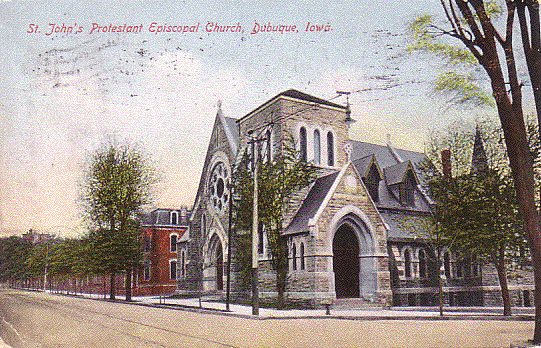Encyclopedia Dubuque
"Encyclopedia Dubuque is the online authority for all things Dubuque, written by the people who know the city best.”
Marshall Cohen—researcher and producer, CNN
Affiliated with the Local History Network of the State Historical Society of Iowa, and the Iowa Museum Association.
ST. JOHN'S EPISCOPAL CHURCH: Difference between revisions
No edit summary |
No edit summary |
||
| Line 11: | Line 11: | ||
Several parts of the building have symbolic meaning. The building is constructed in the form of a cross. The red painted doors symbolize the early Christian martyrs and the blood of Christ. Beams in the vaulted ceiling resemble a boat or ark, symbol of the protection provided by Christian faith. The church, with five Louis Tiffany windows, is an example of [[GOTHIC REVIVAL ARCHITECTURE]]. | Several parts of the building have symbolic meaning. The building is constructed in the form of a cross. The red painted doors symbolize the early Christian martyrs and the blood of Christ. Beams in the vaulted ceiling resemble a boat or ark, symbol of the protection provided by Christian faith. The church, with five Louis Tiffany windows, is an example of [[GOTHIC REVIVAL ARCHITECTURE]]. | ||
The 1987 through 2014 ''Dubuque City Directory'' listed 1458 Locust. | The 1987 through 2014 '''Dubuque City Directory''' listed 1458 Locust. | ||
--- | --- | ||
Revision as of 19:37, 19 April 2021
ST. JOHN'S EPISCOPAL CHURCH. Dubuque became a missionary station of the Episcopal church in 1836. (1) The church was organized on March 31, 1845. On May 14, 1848, the cornerstone was laid for a small brick church at 9th and Locust STREETS. (2) Work on the church, however, was brought to a halt when the son of Reverend De Pui, while on a western trip, was killed and scalped by Native Americans. Rev. Du Puy and his wife moved from Dubuque soon afterward.
The church was left without a minister for nearly one year. Services were held in the court house and later in a small frame building owned by the Baptists. (3) Reverend R. D. Brooke arrived in 1850 from Virginia to become pastor of the church, and work resumed so that the building was consecrated on April 13, 1851. The population of Dubuque at this time was between three and four thousand with the Episcopal congregation to smallest. When the church was dedicated a debt of $1,000 was paid by eastern and southern friends. (4) In July 1864 plans for a large stained glass chancery window were announced as a gift of General Hodgdon, Dr. J. C. Lay, and Mrs. John Williams. (5)
Brooke was removed from his position when he would not preach a sermon favoring the North during the CIVIL WAR. (6) By 1866 church records indicated five hundred members of the congregation.
The call for a new church had first been made in 1857, but the war ended such suggestions. In 1868 a lot, known locally as Norton's Row, was purchased at 14th and Main streets. The price was $6,000 with 25% interest until it was paid in full. This debt was assumed by the six members of the Vestry which included George Greene, Richard Plumb, J. P. Evens, [[BISSELL, Frederick E.|Frederick E. BISSELL], Caleb H. BOOTH, Christopher PELAN, and Albert Gillespie. The PANIC OF 1857 resulted in financial problems for six of the men and the debt was finally assumed John HODGDON. (7) Groundbreaking took place in 1874, but the discovery of quicksand required a deeper foundation. The cornerstone, dated 1875, was not laid until July 10, 1877. (8) Funds for construction came from such varied sources as the Sunday school and two fairs held by the women members of the congregation. The church was constructed between 1875 and 1878 with limestone quarried near Farley, Iowa. It was formally opened on June 9, 1889.
By 1892 disagreements within the church threatened its existence. Debate began in 1891 as to how the children in the vested choir should enter the church--boy first or girls. This spread into arguments of "authority in some temporal matters between the rector and some portions of the vestry." At the Easter election of vestry members, those in the disputes withdrew their names as candidates for re-election and many left the church. The resulting loss of income threatened and led to consideration of a new church under the direction of the Reformed Episcopal Church. (10)
Several parts of the building have symbolic meaning. The building is constructed in the form of a cross. The red painted doors symbolize the early Christian martyrs and the blood of Christ. Beams in the vaulted ceiling resemble a boat or ark, symbol of the protection provided by Christian faith. The church, with five Louis Tiffany windows, is an example of GOTHIC REVIVAL ARCHITECTURE.
The 1987 through 2014 Dubuque City Directory listed 1458 Locust.
---
Source:
1. Heutis, Bertha Lincoln, "Courthouse Scene of First Episcopal Church Service In Dubuque In Early Days," Telegraph-Herald, May 24 1933, p. 19
2. Ibid.
3. Ibid.
4. Ibid.
5. "Recall History of St. John's Church," Telegraph-Herald and Times-Journal, October 22, 1926, p. 7
6. Heustis
7. "St. John's Church," The Herald, June 9, 1889, p. 9
8. "St. John's Church," Dubuque Democratic Herald, July 23, 1864, p. 4. Online: https://news.google.com/newspapers?nid=A36e8EsbUSoC&dat=18640723&printsec=frontpage&hl=en
9. "Recall History..."
10. "Laying of the Corner Stone," Dubuque Herald, July 10, 1877, p. 4. Online: https://news.google.com/newspapers?nid=uh8FjILnQOkC&dat=18770710&printsec=frontpage&hl=en


